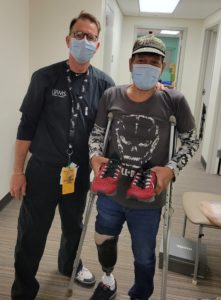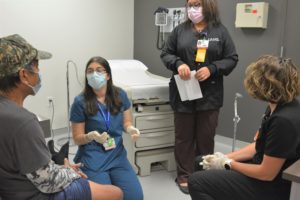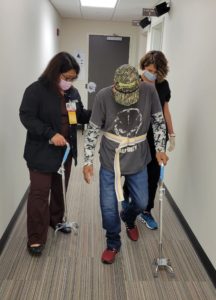Marshallese Man Receives Free Leg Prosthesis Thanks to UAMS, UA and Snell Prosthetics & Orthotics
| May 14, 2021 | When Benson Laikidrik lost the lower part of his right leg due to complications from diabetes, he didn’t have much hope that his quality of life would ever be the same again.
But thanks to a collaborative effort by the University of Arkansas for Medical Sciences (UAMS) in Northwest Arkansas, the University of Arkansas-Fayetteville Biomedical Engineering department, and Snell Prosthetics & Orthotics, Laikidrik has a custom-designed prosthesis that has given him back the mobility to do the things he thought he could never do again.
Laikidrik originally came to the UAMS North Street Marshallese Clinic in Fayetteville for consultation and treatment of his diabetes. It was too late to save his leg, so it had to be amputated below the knee. He didn’t have insurance, and the cost of a prosthesis was more than he could afford.
The clinicians at the North Street Marshallese Clinic, which is a free clinic for Marshallese people in Northwest Arkansas, started talking about how to get him a prosthesis.

Not only did Tom Schulz, M.D. (left), help to get Benson Laikidrik a free prothesis, he donated a pair of Razorback shoes.
“We all just thought, ‘Gosh, wouldn’t it be great if he could get a prosthesis and walk again,’” said Tom Schulz, M.D., director of the clinic and the UAMS internal medicine residency program.
Schulz began to ask around, and it wasn’t long until he checked with the UA Biomedical Engineering department, which has long had a collaborative relationship with UAMS. Assistant professor Mostafa Elsaadany, Ph.D., and associate professor Morten Jensen, Ph.D., presented the idea as a senior project option to one of the UA Biomedical Engineering senior design groups.
The senior design group loved the challenge of the project and the prospect of helping someone walk again. Thus began the initial brainstorming process, where the students set about to develop a methodology that they could implement.
The student team, which consisted of Seth Box, Kyle Potts, Nathalie Cedeno, Reagan Dugan, Alexandria Paton and Zachary Williams, knew they wanted to make a prosthesis, but they had limited resources in the lab and a limited budget. So they started researching, looking specifically at patented prosthetic designs for transtibial prosthetics.
“Out of all the research and brainstorming, the idea that came to the forefront was taking a used prosthesis and doing what we could do to make it fit him,” Box said. “The best way we found to do that was to make a socket, which is the most custom-fitted piece of a prosthesis.”
Because they had a 3D printer in the lab, they started thinking about how they could use that technology to create a cost-effective alternative to traditional sockets, which are made of carbon fiber and fiberglass, materials that are quite expensive.
“No matter what, we were going to get Mr. Laikidrik a free device,” Box said. “That was a goal that we took on.”
Money, however, was still an issue. Although they had a cost-effective solution for the socket, everything else needed for the prosthetic was way above their budget. Enter Snell Prosthetics & Orthotics of Fayetteville, who donated the prosthesis that attaches to the socket the students built.

Greg Johnson of Snell Prosthetics & Orthotics (center) and UA biomedical engineering students (left to right) Seth Box, Kyle Potts, Nathalie Cedeno, and Reagan Dugan show off the prosthesis they designed.
Robert Gullett, M.D., an orthopaedic surgeon at UAMS, recommended Snell Prosthetics & Orthotics as a partner in the project.
“Greg Johnson of Snell Prosthetics & Orthotics has been extremely helpful in helping us bring this project to fruition,” Gullett said. “His efforts show that he is committed to providing excellent patient care and educational opportunities for students at the University of Arkansas. I cannot say enough wonderful things about Snell and Mr. Johnson.”
Johnson praised the students for their hard work and ingenuity.
“I think these guys did great,” Johnson said at the first fitting of the prosthesis. “We at Snell are just grateful we were able to help. Everybody did their part, and we got this guy walking today.”
But Johnson and Snell did more than just donate the most expensive part of the project. At the end of last semester, members of the senior design group toured the facilities at Snell Prosthetics & Orthotics, where they learned about current fabrication and fitting methods used in making a transtibial prosthesis. Johnson led the tour and offered to provide hands-on assistance in making a mold of the patient’s residual limb. He also offered to provide advice as the students made the 3D printed socket for the patient.
“Snell, and Mr. Johnson in particular, came through for us big time,” Box said. “They were extremely generous.”
COVID-19 put a kink in the process, because it took time to make arrangements for the students and Laikidrik to meet safely. But that delay actually gave the students time to practice with various objects to prepare to make the socket. They finally met about two months before the first fitting to take some measurements.
At a second meeting with Laikidrik, the students took a cast mold of his residual limb. They then scanned the mold and used a 3D model of the scan to make the socket using the 3D printer.
On the day of the first fitting of the prosthesis with Laikidrik, the students excitedly and proudly showed off the fully assembled prosthesis. They explained the process for making the socket and demonstrated the state-of-the art functionality of the hydraulic ankle, which flexes and bends when pressure and weight is applied.
“The fitting was the most rewarding part of the process,” Box said. “It doesn’t get any better than that. He was able to put it on and just start walking around. That doesn’t normally happen in the prosthetic world. It usually takes two or three fittings to get it down. That just affirms all the hours of background work that went into getting the device ready. This is life changing for the patient. To give back that mobility to the patient is very fulfilling.”
The UA students’ professors praised the students’ efforts and also thanked UAMS for bringing the project to them in the first place.
“Working with our clinical partners and industry on a project that directly benefits the community is a perfect example of the ‘real-life’ biomedical engineering experience we try to give our senior design students,” Jensen said.
“This was a very impactful and meaningful project,” Elsaadany said. “The students were very enthusiastic from day one. They took a full leadership role and managed the project on their own. Our department has enjoyed an ongoing collaboration with Dr. Schulz and UAMS. We are so thankful he contacted us about getting the students involved in this project.”
Johnson and the UAMS and UA teams conducted a second fitting for the patient, and additional adjustments may be necessary as he uses the prosthesis regularly.

Benson Laikidrik speaks with physical therapy assistant professor Liz Garcia, clinical interpreter Terry Takamaru, and physical therapy student Megan James.
In the meantime, another UAMS team has stepped in to help Laikidrik adjust to his renewed mobility. Liz Garcia, DPT, is an assistant professor in the physical therapy department on the UAMS Northwest Regional Campus. Garcia is supervising a group of physical therapy students as they work with Laikidrik in the North Street Marshallese Clinic, which is part of UAMS’ interprofessional education (IPE) program that focuses on a collaborative approach across all health care professions.
Garcia explained that Laikidrik’s physical therapy treatment focuses on three things: education on skin protection; leg stretches to make sure he has the needed range of motion to walk; and adjustment of the shoe for improved prosthesis fit, then trials of ambulation.

Benson Laikidrik works with clinical interpreter Terry Takamaru (left) and physical therapy student Megan James.
Throughout the entire process, one person has been a constant presence and an integral part of Laikidrik’s care. UAMS clinical interpreter Terry Takamaru was instrumental in helping the patient and his wife understand the process and with getting him to all the appointments. Takamaru was by Laikidrik’s side from the beginning, whether it was on the phone, in person, or during appointments.
“I am grateful and privileged to work with a group of passionate professionals who are willing to think outside the box to better serve the underserved,” Takamaru said. “This is just one of the many great efforts UAMS has contributed despite all the barriers we come across trying to serve the community.”
“If you look in the dictionary under collaboration, you should see this project,” Schulz said. “Each group and person was essential to the process. I am absolutely humbled by the collaborative spirit of everyone involved.”



